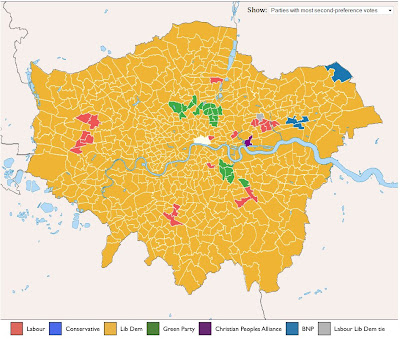As well as electing the next Mayor of London this Thursday, we also get to vote for who represents us on the London Assembly. There are 14 constituency Assembly Members and 11 London-wide members elected based on proportional representation.
In West Hampstead, our constituency is Barnet and Camden, and that means we have to choose between incumbent Brian Coleman (Con), Andrew Dismore (Lab), Chris Richards (LD), Audrey Poppy (Green – with a name like that, had to be), and Michael Corby (UKIP – or “Fresh Choice for London” as they’ve somehow managed to get themselves billed in the official London Elects brochure).
Do we care about who speaks for us at City Hall? Assembly members don’t have a great deal of power, you can read the official line as to the role of the Assembly. The thrust of it is to hold the mayor to account, campaign on various issues, and potentially get involved in large-scale planning issues. One might argue it’s not that important, although one could imagine that if the Assembly was dominated by the same party as the Mayor’s, then there might be a little less scrutiny.
As for the candidates, well, it’s fair to say that Brian Coleman is a controversial figure. I’m not going to list the litany of criticisms that he’s faced – the very fact that there’s a website called “101 Reasons to Sack Brian Coleman“, gives you an indication of his unpopularity in certain circles. From racking up extortionate taxi bills at the taxpayers’ expense, to dismissing perfectly legitimate questions out of hand, this is one elected official who doesn’t kow tow to his voters.
 |
| Coleman (left) aiming lower than erstwhile H&K candidate Chris Philp |
He’s spotted in West Hampstead from time to time, chatting up small business owners or generally waving the blue flag around election time, but he’s really a Barnet politician (and erstwhile Mayor of the borough). He famously dislikes bloggers. During the general election one Tory aide asked me in front of him whether I’d like to interview him. We answered in unison; him with a pithy “I don’t do bloggers”, and me with a marginally more polite “No thanks, he’s not that interesting to our readers at the moment”.
He objected to both the 187-199 West End Lane development and the Abbey Area development proposals before they went to City Hall but clearly his objections carried little weight as both were passed without amendment. I asked (at very short notice) two of Camden’s Conservative councillors to tweet me a reason to vote for Coleman. Gio Spinella’s reply: “[he has] a proven track-record of sound and firm management with London’s Fire Brigades and one undeniable virtue: with Brian Coleman you will always know where you stand. He won’t equivocate or pander.” Which is probably about as diplomatic as you can get.
Coleman has been in trouble with Barnet council three times this year already. “The council’s standards committee upheld complaints from two members of the public that he had been disrespectful in a series of email exchanges, including one in which he said a lobbyist would have been a member of the fascist Blackshirts 70 years ago,” reported the Barnet & Whetstone Times. Then on April 4th, he is alleged to have called a resident a “twat” and told them to “clear off” during a cabinet meeting open to the public. This wasn’t in response to some abuse, it was in response to a question on the closure of Friern Barnet Library.
I try quite hard to be non-partisan on this blog, but I find it very hard to endorse any politician who appears to have such disdain for his constituents. Or as respected London political commentator Dave Hill puts it, “Coleman personifies vividly a comedic suburban affrontedness rarely found outside of television sitcoms. The spectacle of someone completely in the grip of his own, inexhaustible indignation provides an unexpected intellectual satisfaction.”
Andrew Dismore is a former MP (for Hendon, 1997 to 2010). He’s thought to have a real chance of beating Coleman, especially if Labour’s support in Camden holds up and enough Tory voters decide that they’d rather elect someone who didn’t call the fire brigade union members “thick” (one of Coleman’s three public jobs is as Chair of the London Fire and Emergency Planning Authority).
Dismore’s experience in Westminster puts him in good stead for the Assembly. While an MP, he chaired the London group of Labour MPs, and was a strong advocate for decent affordable homes – a critical requirement for London both now and in the future.
It’s true that Dismore had his spending come under scrutiny during the MP expenses scandal although he was subsequently cleared by the Committee on Standards in Public Life. Nevertheless, he is almost certainly the only credible competitor to Coleman, and he certainly talks the talk:
“My reputation as a councillor and as an MP was of someone who worked hard for his constituents, and I will do the same as your assembly member. I will be visible, active and engaged. I will not be like the present Conservative incumbent AM, who in the three years since he was last elected, has not written once to the police to raise Safer Neighbourhood Team staffing and deployment issues, nor to Transport for London to raise the Northern Line upgrade, the strategic bus network, or cycling issues, nor to senior Camden council officers about anything at all.”
What of the other candidates? Lib Dem Chris Richards may be Bromley-born, but he’s a Camden boy now, so those of us in the southern reaches of the enormous Barnet & Camden constituency might feel he has more to offer although he lacks the political experience and gravitas of Coleman or Dismore. I can’t find anything about the Greens’ Audrey Poppy except that she came 4th in the 2005 general election in Chipping Barnet. UKIP’s Michael Corby wanted to be the party’s mayoral candidate, and he sets out his stall in this video. The Barnet Eye has an interesting take on the role UKIP could have played in this election: given Coleman’s unpopularity with some voters, UKIP might have expected to pick up votes here, which would have helped them secure seats in the Assembly based on the proportional representation formula. However, Corby has been the “invisible man” in this election.
Coleman does appear, for the first time, to be running scared. Last Friday he apparently went round local shops in High Barnet that had put up anti-Coleman posters and bullied shopkeepers into removing them. One shopowner said, ““He was going mad and shouting. He was right in my face and wouldn’t leave when I asked him. He was intimidating.”
When you go to vote for the mayor on Thursday, don’t automatically tick the London Assembly box that corresponds to your general party affiliation. Have a think about the role of Assembly Members, which is more consultative than executive, and about the type of person you believe should represent you.








